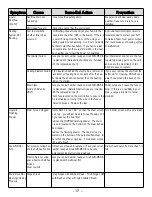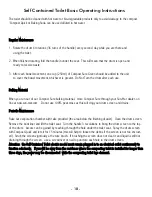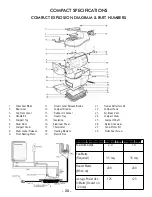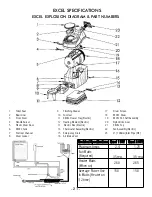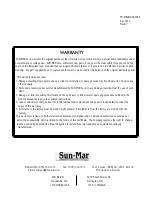
Seasonal Use and Spring time Start Up
EEm
mppttyy CCoom
mppoosstt ffrroom
m LLaasstt SSeeaassoonn
Before your first use of the unit, extract compost from the drum by releasing the drum locker (located above the
drawer opening), then rotate the handle counter-clockwise giving the drum one complete revolution only. Compost
from the drum will drop into the finishing drawer. Empty the drawer and repeat this procedure until most of the
compost is removed, leave 4-6 “ of compost. This will be your “starter base” for the coming season.
RRaakkee
Remove the finishing drawer completely and use the rake tool to rake any loose material from the floor of the
unit. Pay careful attention to the back two corners of the unit (near the safety drain) to ensure that your drains
do not get clogged.
AAdddd WWaatteerr && M
Miiccrroobbee M
Miixx
Add some warm water to the remaining compost, enough to ensure that it is quite moist. Also, add some Sun-Mar
Microbe Mix (two of scoops) to give the compost pile a “kick-start” and rotate the drum several times to mix.
If your composting toilet is electric, plug it in and use for another season.
Winter Use
NNoo WWiinntteerr UUssee
Just add water. Lots of water. Soak the compost in the drum to prevent it from drying out before Spring. Make
sure to unplug the unit if electric. If you have a non-electric unit, it may be a good idea to place something over
the diffusor to prevent
animals (who are looking for a home at this time of year) from getting in.
OOccccaassiioonnaall WWiinntteerr UUssee
If the unit will be used for 3-4 weekends throughout the winter season then it is considered occasional use. All of
the same considerations should be taken with these units to winterize them. When the temperature dips below 55
° F (13 ° C), composting activity will decrease dramatically. These units do not need to be kept warm and will act
only as a holding tank during the winter months until they warm up enough in the spring to begin composting
again. During the winter, the compost will freeze into a solid mass so the drum should not be turned as it may
damage the composting toilet. With this in mind, it is a good idea to remove enough compost before it gets too
cold to make room in the drum for winter use.
HHeeaavvyy oorr RReessiiddeennttiiaall WWiinntteerr UUssee
These units should be kept in a heated area and all winterization tips should be followed, including the following:
1. Vent Pipe - electric models; All 2" vent pipe should be insulated if they are exposed to the outside or in an
unheated area. If you are in an area that experiences extreme winter conditions, we recommend that heat tape
should be applied to the exposed vent pipe to prevent ice blockages.
2. Safety Drain - all models; We recommend that the safety drain should be installed and insulated above the frost
line. There will be less evaporation in the winter so this will help with any excess liquid. If possible, heat tape
can be applied to the safety drain to prevent ice blockage.
3. Keep it warm; If the composting toilet is used frequently in the winter then the composting part of the unit
should be kept in a warm place. Below 55 ° F (13 ° C), composting actions slows dramatically so if it is in a
place that falls below this temperature, a source of heat should be provided for the unit so that it can keep up
with constant use.
- 12 -



















